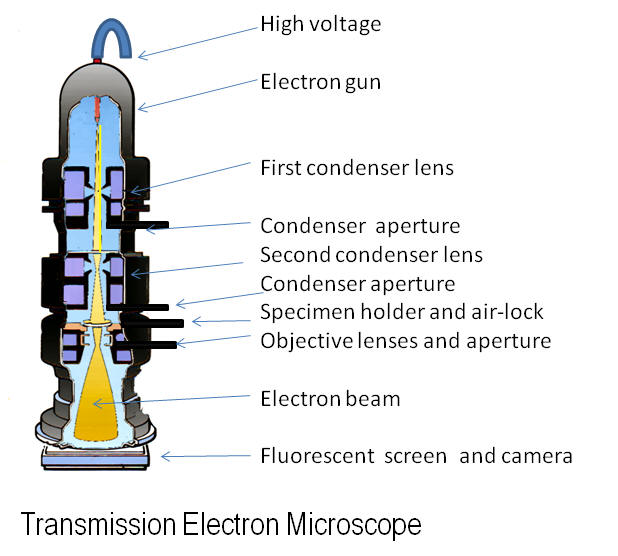Page Title
Subtitle
Body Shots

Did you know? - An electron microscope is a type of microscope, a scientific instrument which is used to magnify things on a fine scale. That uses a particle beam of electrons to illuminate a specimen and create a highly-magnified image. Electron microscopes have much greater resolving power than light microscopes that use electromagnetic radiation and can obtain much higher magnifications of up to 1 million times, while the best light microscopes are limited to magnifications of 1000 times. Both electron and light microscopes have resolution limitations, imposed by the wavelength of the radiation they use. The greater resolution and magnification of the electron microscope is because the de Broglie wavelength of an electron is much smaller than that of a photon of visible light. The electron microscope uses electrostatic and electromagnetic lenses in forming the image by controlling the electron beam to focus it at a specific plane relative to the specimen. This manner is similar to how a light microscope uses glass lenses to focus light on or through a specimen to form an image.
15 amazing body shots captured using a scanning electron microscope. Incredible details of 1 to 5nm (nanometer) in size can be detected. A nanometer is about one billionth (1,000,000,000) of a meter (39.37 inches).

1. Red Blood Cells - They look like little cinnamon candies here, but they're actually the most common type of blood cell in the human body - red blood cells (RBCs). These biconcave-shaped cells have the tall task of carrying oxygen to our entire body; in women there are about 4 to 5 million RBCs per micro liter (cubic millimeter) of blood and about 5 to 6 million in men. People who live at higher altitudes have even more RBCs because of the low oxygen levels in their environment.

2. Split End of Human Hair - Regular trimmings to your hair and good conditioner should help to prevent this unsightly picture of a split end of a human hair.

3. Purkinje Neurons - Of the 100 billion neurons in your brain. Purkinje (pronounced purr-kin-jee) neurons are some of the largest. Among other things, these cells are the masters of motor coordination in the cerebellar cortex. Toxic exposure such as alcohol and lithium, autoimmune diseases, genetic mutations including autism and neurodegenerative diseases can negatively affect human Purkinje cells.

4. Hair Cell in the Ear
Here's what it looks like to see a close-up of human hair cell stereo cilia inside the ear. These detect mechanical movement in response to sound vibrations.

5. Blood Vessels Emerging from the Optic Nerve - In this image, stained retinal blood vessels are shown to emerge from the black-colored optic disc. The optic disc is a blind spot because no light receptor cells are present in this area of the retina where the optic nerve and retinal blood vessels leave the back of the eye.

6. Tongue with Taste Bud - This colour-enhanced image depicts a taste bud on the tongue. The human tongue has about 10,000 taste buds that are involved with detecting salty, sour, bitter, sweet and savory taste perceptions. Thai people have very few -- most killed by eating spicy food.

7. Tooth Plaque - Brush your teeth often because this is what the surface of a tooth with a form of “corn-on-the-cob†plaque looks like.

8. Blood Clot - Remember that picture of the nice, uniform shapes of red blood cells you just looked at? Well, here's what it looks like when those same cells get caught up in the sticky web of a blood clot. The cell in the middle is a white blood cell.

9. Alveoli in the Lung - This is what a colour-enhanced image of the inner surface of your lung looks like. The hollow cavities are alveoli; this is where gas exchange occurs with the blood.

10. Lung Cancer Cells - This image of warped lung cancer cells is in stark contrast to the healthy lung in the previous picture.

11. Villi of Small Intestine - Villi in the small intestine increase the surface area of the gut, which helps in the absorption of food. Look closely and you will see some food stuck in one of the crevices.

12. Human Egg with Coronal Cells - This image is of a purple, colour-enhanced human egg sitting on a pin. The egg is coated with the zona pellicuda, a glycoprotein that protects the egg but also helps to trap and bind sperm. Two coronal cells are attached to the zona pellicuda.

13. Sperm on the Surface of a Human Egg - Here's a close-up of a number of sperm trying to fertilize an egg.

14. Human Embryo and Sperm - It looks like the world at war, but it is actually five days after the fertilisation of an egg, with some remaining sperm cells still sticking around. This fluorescent image was captured using a confocal microscope. The embryo and sperm cell nuclei are stained purple while sperm tails are green. The blue areas are gap junctions, which form connections between the cells.

15. Colored Image of a 6 day old Human Embryo Implanting itself onto the wall of the womb